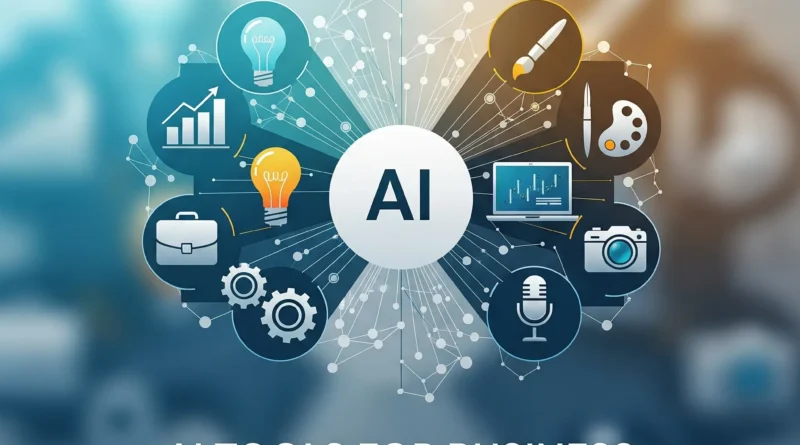Best AI Tools for Business and Freelancing in 2025 – A Comprehensive Beginner’s Guide
Introduction: Why AI Tools Are Essential for Businesses and Freelancers in 2025
In 2025, artificial intelligence (AI) has transformed from a futuristic concept into a cornerstone of modern business and freelancing, empowering small business owners and solopreneurs to compete with industry giants. The freelance economy is thriving, with over 1.57 billion freelancers globally projected to contribute $455.2 billion to the economy by 2025, according to Upwork’s 2025 Freelance Forward report. Meanwhile, small businesses face increasing pressure to deliver personalized, efficient services amidst rising competition and customer expectations. AI tools bridge this gap by automating repetitive tasks, enhancing creative output, and providing data-driven insights that were once exclusive to large enterprises with hefty budgets. For beginners, the accessibility of freemium AI tools means you can start experimenting without significant upfront costs. McKinsey’s 2025 AI adoption survey highlights that while nearly all companies are investing in AI, only 1% feel fully mature in its implementation, creating a unique opportunity for new adopters to gain a competitive edge. This comprehensive guide is designed specifically for those new to AI, offering a detailed breakdown of the best tools for content creation, project management, marketing, and customer relations. By integrating these tools, you could save up to 40% of your workweek, as seen with platforms like Zapier and ClickUp, and potentially increase revenue by streamlining operations. Whether you’re a freelancer juggling multiple clients or a small business owner aiming to scale, this guide will walk you through the top AI tools for 2025, with practical tips, pricing details, and real-world use cases to help you build a powerful AI-driven workflow.

The Transformative Power of AI for Businesses and Freelancers
AI tools are revolutionizing how small businesses and freelancers operate by automating mundane tasks, enhancing productivity, and unlocking new revenue streams. For instance, AI can handle up to 70% of routine administrative tasks like scheduling, invoicing, and data entry, freeing you to focus on high-value activities such as client acquisition or creative strategy. The cost savings are equally compelling: AI-powered content creation tools can reduce outsourcing expenses by up to 80%, while automation platforms like Zapier streamline workflows across multiple apps, saving hours weekly. For freelancers, this means taking on more projects without burnout; for businesses, it translates to scaling operations without hiring additional staff. Moreover, AI’s ability to analyze customer data enables personalized marketing at scale, with tools like Apollo.io increasing lead conversion rates by 20-35% through targeted outreach. Beginners can start small by identifying one or two pain points—say, time spent on manual invoicing or brainstorming social media content—and testing a single tool to address it. Webex’s 2025 report on AI productivity emphasizes that modern AI tools prioritize seamless integration with platforms like Google Workspace, Microsoft 365, and Slack, making adoption intuitive even for non-tech-savvy users. The key is to approach AI as a partner, not a replacement, ensuring it enhances your unique skills and business vision. By starting with free tiers and gradually scaling, you can build a robust AI stack tailored to your needs, setting the stage for exponential growth in 2025 and beyond.
Top AI Tools for Content Creation and Marketing
Content remains a critical driver of engagement in 2025, but creating high-quality blogs, social media posts, or ad campaigns can be time-intensive and costly without the right tools. Fortunately, AI-powered content creation platforms have evolved to deliver professional-grade outputs with minimal effort, making them ideal for freelancers crafting client deliverables or businesses building their brand. Below, we explore three standout tools that dominate the content and marketing space, complete with features, pricing, and beginner-friendly tips to maximize their potential.
1. Jasper AI: The Ultimate Writing Companion
Jasper AI continues to lead the pack in 2025 for generating SEO-optimized blog posts, social media captions, email newsletters, and ad copy. Its advanced natural language processing (NLP) capabilities, powered by cutting-edge models, allow it to produce long-form content with improved coherence and factual accuracy, complete with built-in fact-checking to minimize errors. For businesses, Jasper’s brand voice customization ensures content aligns with your tone, while freelancers benefit from its template library for quick-turnaround deliverables like client proposals or website copy. The platform’s 2025 updates include enhanced multilingual support, making it a go-to for global freelancers serving diverse markets. To get started, input a simple prompt like “Write a 500-word blog post on sustainable business practices for a small retail brand” and tweak the output for tone and keywords. Pricing starts at $39/month for the Pro plan, but the investment pays off quickly—freelance marketers report a 25% increase in social media engagement after using Jasper to craft 10 LinkedIn posts in under an hour. Beginners should leverage Jasper’s integration with WordPress and Google Docs to streamline publishing workflows, ensuring content is ready to go live with minimal formatting. For those new to AI writing, Jasper’s intuitive interface and prompt suggestions make it easy to experiment without feeling overwhelmed, positioning it as a must-have for content-heavy workflows.
2. ChatGPT (OpenAI): The Versatile Brainstorming Powerhouse
ChatGPT, developed by OpenAI, remains a household name in 2025, thanks to its versatility and accessibility. Its latest updates include multimodal capabilities (handling text, images, and even basic code) and custom GPTs tailored for niche tasks like SEO keyword research, brainstorming, or customer service scripting. The free tier is robust enough for beginners, offering real-time collaboration and translation features, while the Plus plan ($20/month) unlocks advanced models for complex tasks like generating Python scripts or analyzing spreadsheets. Freelancers can use prompts like “Brainstorm 10 creative Instagram captions for a fitness coaching service” to spark ideas, while small businesses automate customer FAQs, reducing support tickets by up to 40%. For beginners, ChatGPT’s strength lies in its flexibility—whether you’re drafting emails, generating taglines, or researching market trends, it adapts to your needs. Pair it with tools like Zapier or Slack for automated workflows, such as sending AI-generated responses to client inquiries directly from your inbox. To avoid generic outputs, refine prompts with specific details (e.g., “target audience: millennials, tone: witty”). ChatGPT’s low barrier to entry makes it an ideal starting point for those dipping their toes into AI, offering immediate value without requiring technical expertise.
3. Canva Magic Studio: Effortless Visual Content Creation
Visual content is non-negotiable for engaging audiences in 2025, and Canva’s Magic Studio makes it accessible for non-designers. This AI-powered suite transforms text prompts into professional-grade logos, social media graphics, videos, and infographics, eliminating the need for expensive design software or outsourced talent. Features like background removal, auto-resizing for different platforms, and AI-driven video editing make it a favorite for freelancers in social media management or event planning. The free tier is generous, while the Pro plan ($12.99/month) unlocks premium templates and advanced editing tools. Beginners can start by uploading a rough sketch and using the “Magic Design” feature to turn it into a polished banner or flyer. For example, a freelance event planner saved $200 per project by creating branded promotional materials in-house, delivering client-ready visuals in minutes. Canva’s integrations with social platforms like Instagram and LinkedIn allow direct posting, streamlining your workflow. For SEO, ensure visuals include alt text with keywords like “2025 business branding” to boost discoverability. New users should explore Canva’s tutorials to master features like animation, ensuring their content stands out in a crowded digital space.
| Tool | Best For | Free Tier? | Integration |
|---|---|---|---|
| Jasper | Long-form copy | No | Google Docs, WordPress |
| ChatGPT | Ideation & short tasks | Yes | Zapier, Slack |
| Canva | Visual content | Yes | Social platforms |
These tools work best when combined—use Jasper for text, Canva for visuals, and Zapier to automate posting, creating a seamless content pipeline.
AI Tools for Project Management and Automation
Managing projects efficiently is a make-or-break factor for freelancers balancing multiple gigs and businesses coordinating small teams. In 2025, AI-driven project management tools not only organize tasks but also predict bottlenecks, suggest priorities, and automate repetitive workflows. Below are three top picks that cater to both solo entrepreneurs and growing businesses, designed to simplify operations and boost productivity.
4. Notion AI: The All-in-One Workspace Revolution
Notion has evolved into a powerhouse for freelancers and small businesses, with its AI features turning static databases into dynamic assistants that summarize notes, generate task lists, and even answer questions about your projects. In 2025, Notion AI’s ability to process large datasets makes it ideal for creating client portals, tracking project milestones, or organizing content calendars. Freelancers use it to manage client deliverables, while businesses leverage it for collaborative planning across teams. The free tier is robust for solo users, with the AI add-on priced at $8-10 per user/month for advanced features like auto-table generation and brainstorming prompts. Beginners can start by asking Notion AI to “Summarize this 2,000-word meeting transcript into key action items,” saving hours of manual note-taking. A freelance writer reported cutting administrative time by 50% after using Notion to organize 15 client projects in a single workspace. To maximize value, integrate Notion with tools like Slack or Google Drive for real-time updates, and explore templates like “Freelance CRM” to streamline client interactions. For those new to project management software, Notion’s clean interface and guided AI prompts make it approachable, though beginners should allocate a weekend to set up their workspace for optimal results.
5. ClickUp AI: Mastering Task and Time Management
ClickUp’s AI capabilities have made it a standout for 2025, offering predictive analytics to identify project delays and suggest task priorities based on deadlines and team capacity. Its role-based prompts cater to specific professions, such as “Generate a content calendar for a freelance social media manager,” making it highly relevant for diverse users. The free tier supports basic task management, while the Unlimited plan ($7/user/month) plus AI add-on ($5) unlocks advanced features like time estimates and dashboard insights. Upwork freelancers benefit from a 20% discount, making it budget-friendly. Beginners should start with ClickUp’s pre-built templates, like the “Freelance Dashboard,” and let AI populate tasks based on project goals. A small consulting firm used ClickUp AI to automate reporting, achieving 95% on-time project delivery—a 20% improvement over manual methods. To avoid overwhelm, focus on one feature at a time, such as time tracking, before exploring integrations with tools like Zoom or Trello. ClickUp’s scalability makes it suitable for both solo freelancers and growing businesses, but its learning curve requires patience for non-tech-savvy users.
6. Zapier AI: The King of No-Code Automation
Zapier remains the gold standard for no-code automation, connecting over 6,000 apps to create seamless workflows, or “Zaps,” that eliminate manual data entry. Its 2025 AI enhancements allow users to create Zaps using natural language, such as “When I receive a new email lead, add it to Google Sheets and send a Slack notification.” This makes it accessible for beginners who lack coding skills. The free tier supports basic automations, while the Pro plan ($19.99/month) handles high-volume tasks for scaling businesses. Freelancers use Zapier to automate invoicing triggers, while small businesses streamline CRM updates, with one freelancer saving 10 hours weekly by auto-scheduling social posts from Trello cards. To get started, map out a repetitive task (e.g., transferring form responses to a CRM) and use Zapier’s AI to suggest the best apps to connect. Its error-handling features ensure workflows run smoothly, but beginners should test Zaps on a small scale to avoid glitches. By combining Zapier with tools like Notion or ClickUp, you can create a fully automated project pipeline, maximizing efficiency without hiring additional staff.
| Tool | Best For | Free Tier? | Scalability |
|---|---|---|---|
| Notion AI | Knowledge bases | Yes | Solo to teams |
| ClickUp | Task tracking | Yes | Enterprise-ready |
| Zapier | App integrations | Yes | High-volume automations |
Pro Tip: Experiment with free tiers to prototype workflows, then upgrade as your client base or team grows to handle more complex automations.
AI for Sales, CRM, and Customer Service
Building and retaining a client base is critical for freelancers and businesses, and AI tools in 2025 make it easier to generate leads, personalize outreach, and provide stellar customer support. These platforms leverage data analytics and automation to enhance client interactions, ensuring you stay competitive in a crowded market.
7. Apollo.io: The Lead Generation Powerhouse
Apollo.io is a game-changer for freelancers and businesses seeking to expand their client base through targeted lead generation. Its AI-driven platform scores leads based on fit, automates personalized email sequences, and integrates with CRMs like HubSpot and Salesforce. In 2025, Apollo’s LinkedIn scraping and real-time analytics help users identify high-value prospects, making it ideal for B2B freelancers or small businesses targeting niche industries. The free tier offers basic lead access, while the Basic plan ($49/month) unlocks advanced sequencing and reporting. Beginners can start by filtering leads by industry or company size and crafting emails with Apollo’s AI suggestions, such as “Personalized cold email for a SaaS startup CEO.” A freelance agency reported booking 20% more discovery calls after using Apollo’s optimized outreach sequences. To maximize ROI, combine Apollo with a CRM and track conversion metrics weekly. New users should focus on small campaigns (10-20 leads) to refine their approach before scaling, ensuring compliance with email regulations like GDPR to avoid penalties.
8. Claude AI (Anthropic): The Ethical Chatbot Alternative
Developed by Anthropic, Claude AI is a business-friendly alternative to ChatGPT, excelling in tasks like report summarization, client email drafting, and compliance-heavy workflows. Its 2025 updates include long-context handling (processing up to 200,000 tokens) and integrations with tools like Slack, making it ideal for freelancers in regulated industries like finance or healthcare. The free tier supports basic tasks, while the Pro plan ($20/month) unlocks advanced features. Beginners can use prompts like “Draft a polite follow-up email for a missed client deadline” to maintain professionalism. Small e-commerce businesses have reduced chat support response times by 60% using Claude’s automated replies. Its emphasis on ethical AI ensures outputs are safe and bias-free, a key consideration for client-facing roles. Start by testing Claude for internal tasks like summarizing research before deploying it for customer interactions, and always review outputs for tone and accuracy to align with your brand.
9. Otter.ai: Revolutionizing Meeting Productivity
Otter.ai transforms how freelancers and businesses handle meetings by transcribing calls in real time, identifying speakers, and extracting actionable insights. Its 2025 features include AI-generated summaries and task assignments, making it a must-have for client consultations or team briefings. The free tier offers 300 minutes of transcription monthly, while the Pro plan ($8.33/month) adds integrations with Zoom and Microsoft Teams. Beginners can connect Otter to Zoom for automatic note-taking, ensuring no detail is missed during client calls. A freelance coach reported handling 30% more sessions by eliminating manual note-taking, thanks to Otter’s accuracy and searchability. To get started, record a test meeting and review Otter’s summary to refine its output for your needs. Pair it with Notion or ClickUp to auto-sync action items, creating a seamless workflow from meeting to execution.
Specialized AI Tools for Freelancers and Niche Businesses
Beyond general-purpose tools, 2025 offers specialized AI solutions for specific professions, from writing and coding to video production. These cater to freelancers in creative or technical fields and businesses with niche requirements.
10. Grammarly Business: Polishing Professional Communication
Grammarly Business goes beyond basic spell-checking in 2025, offering AI-driven tone adjustments, style guides, and plagiarism detection to ensure polished communication. Freelancers use it to refine proposals, while businesses enforce consistent messaging across teams. The free tier corrects grammar, while the Premium plan ($12/month) unlocks advanced rewriting and analytics. A freelance writer reported landing 15% higher rates after using Grammarly to enhance client pitches. Beginners should start by uploading a draft email and experimenting with tone settings like “confident” or “friendly” to match client expectations. Integrate Grammarly with Chrome or Microsoft Word for real-time edits, ensuring error-free deliverables.
11. GitHub Copilot: Accelerating Development for Tech Freelancers
GitHub Copilot, powered by OpenAI, is a lifeline for freelance developers, suggesting code snippets and auto-completing functions across 20+ programming languages. In 2025, it speeds up development by up to 55%, allowing coders to deliver apps or websites faster. Priced at $10/month, it integrates with IDEs like VS Code. A freelance developer completed a mobile app project twice as fast using Copilot’s suggestions, boosting client satisfaction. Beginners should start with small scripts and review Copilot’s outputs to ensure accuracy, gradually scaling to complex projects. Its low cost and high impact make it a must for tech freelancers.
12. Synthesia: Text-to-Video for Effortless Content
Synthesia creates professional videos from text prompts, perfect for training materials, marketing campaigns, or client onboarding. Its customizable avatars and multilingual support cater to global audiences. Starting at $22/month, it’s a cost-effective alternative to hiring videographers, with businesses cutting production costs by 70%. Beginners can create a short explainer video by inputting a script and selecting an avatar. Combine Synthesia with Canva for a complete content strategy, ensuring your visuals and videos align seamlessly.
For developers, TabNine offers similar code autocompletion, while creatives can explore Stable Diffusion for AI-generated images, both tailored to niche needs.
How to Choose and Implement AI Tools as a Beginner
Adopting AI tools can feel daunting, but a structured approach ensures success. First, assess your top three pain points—whether it’s slow content creation, disorganized projects, or inefficient client outreach—and match them to tools like Jasper, ClickUp, or Apollo.io. Test free versions to experiment without risk, focusing on platforms with integrations to your existing stack (e.g., Google Workspace or Microsoft 365). Prioritize tools with clear ROI—aim for those that save enough time or money to cover costs within 1-2 months. Ethical use is critical; AI should enhance, not replace, your unique value, and GDPR-compliant tools like Claude ensure data privacy. Avoid overloading your workflow—start with 3-5 tools and scale as you gain confidence. Common pitfalls include neglecting training (use free resources like YouTube tutorials) or ignoring analytics to measure impact.
Real-World Success Stories
- Freelance Marketer: Combined Jasper and Zapier to automate 80% of their content pipeline, doubling client capacity in Q1 2025.
- Small E-Commerce Business: Used Apollo.io and Otter.ai to streamline sales calls and follow-ups, boosting conversions by 35%.
- Solo Consultant: Leveraged Notion AI to organize a knowledge base, reducing research time from days to hours and improving client delivery.
The Future of AI in Business and Freelancing
Looking ahead, McKinsey predicts that by 2026, agentic AI—autonomous systems that handle end-to-end tasks—will dominate, automating entire workflows like lead nurturing or content scheduling. To stay ahead, upskill through free resources like Coursera’s AI courses or xAI’s developer blog. Early adoption of these tools positions you for long-term success in an AI-driven economy.
Conclusion: Kickstart Your AI Journey Today
The best AI tools for business and freelancing in 2025 empower you to work smarter, not harder. From Jasper’s polished copy to Zapier’s silent automations, these 12 tools offer a beginner-friendly path to efficiency and growth. Start with one tool this week, integrate it into your workflow, and track the time saved. Share your first step in the comments, and let’s build your AI-powered future together!




